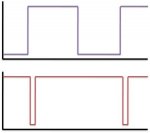Cosmic Software
Member
I am strugling to work out a suitable method of creating a certain logic signal to reset an IC when a USB plug is inserted.
The first graph shows the +5V supply from the USB, and the second graph shows the signal that I want to generate in accordance to the first graph.
I hope that it makes some sense, and someone is able to offer me advice because I have looked everywhere that I can think of to try and come up with a solution.
Thanks.
The first graph shows the +5V supply from the USB, and the second graph shows the signal that I want to generate in accordance to the first graph.
I hope that it makes some sense, and someone is able to offer me advice because I have looked everywhere that I can think of to try and come up with a solution.
Thanks.
Attachments
-
12.9 KB Views: 6
Last edited:



